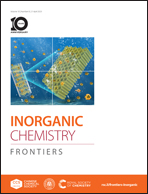Metal-free catalytic conversion of CO2 into methanol: local electrophilicity as a tunable property in the design and performance of aniline-derived aminoborane-based FLPs†
Abstract
A deeper computational mechanistic study of an environmentally friendly metal-free CO2 reduction process towards obtaining methanol is presented, employing a previously tested kind of intramolecular frustrated Lewis pair (2-[bis(R)boryl]-N,N-dimethylaniline) as the catalyst and H2 as the reducing agent. The Lewis acid strength of the electrophilic boron atom was adjusted to facilitate hydride release by changing the R group, using electron-donating groups (EDGs) based on methylated aryls (Mes and Mes′) and electron-withdrawing groups (EWGs) based on fluorinated alkyls (CF3 and PFtB) and aryls (FMes and C6F5), to analyse its effect on both the H2 splitting and CO2 hydrogenation processes. The acidity of boron was measured from the local electrophilicity index obtained using conceptual density functional theory, where an excellent correlation with the Gibbs free energy of the H2 splitting process was found (R2 = 0.95), indicating that the higher the acid power of boron is, the more exergonic the H2 activation process is. The reversibility of H2 activation directly impacts the CO2 and formic acid hydrogenations, where the less exergonic the H2 splitting process is, the lower the activation energies for these hydrogenation processes are. To obtain methanol at the end, methanediol dehydration forming formaldehyde is crucial, because methanediol has a high energetic barrier, hindering the catalytic cycle from being more efficient. Conversely, formaldehyde can be easily hydrogenated to methanol in the same way as CO2 and formic acid. Finally, the catalytic activity in each case was analysed in terms of the energetic span model, where the local electrophilicity index condensed on boron shows a good linear correlation with the logarithm of the relative turnover frequency (R2 = 0.91), indicating that this reactivity index can be employed to guide the design of optimal catalytic systems to increase its catalytic activity, opening new routes directing future experiments in the field.

- This article is part of the themed collection: Celebrating Latin American Chemistry


 Please wait while we load your content...
Please wait while we load your content...